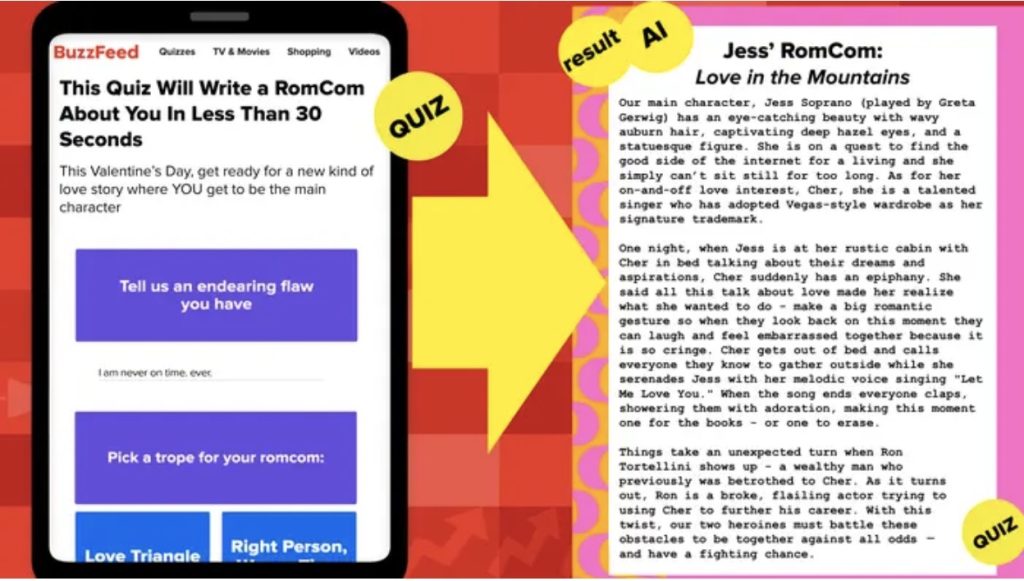I clearly remember the moment someone showed me how Napster worked for the first time. I was just a clueless high-schooler, but it was still obvious I was witnessing something that would eventually change everything.
It didn’t happen overnight – the iPod didn’t even exist yet, let alone Spotify – but the trajectory was set, and all but inevitable.
Napster was the watershed moment for digital content, and the rest is history.

Similarly, ChatGPT has proven to be a pivotal breakthrough for AI, capturing the fascination of the public at large – along with the consternation of some who understand its knock-on implications.
The ability to create a unique and credible-sounding essay in 30 seconds from a simple prompt sounds downright heavenly to your average university student or freelance writer at first pass – until you play out some scenarios, and begin to realize where this is ultimately headed.
Regardless, it seems all but inevitable that a tsunami of AI content is heading our way. Let’s take a closer look at what this means for us as internet entrepreneurs, both in terms of challenges – and opportunities.
Part 1: Passing the Turing Test

Alan Turing was an English computer scientist who is best known for discovering how to decipher encrypted German communications in WW2 – a pivotal breakthrough for the Allies.
He also developed a sort of “threshold” for artificial intelligence first known as the Imitation Game, and later called the Turing Test. Broadly speaking, it was a process designed to see if a machine could truly exhibit behavior and communication that was indistinguishable from a human.
For decades, this was considered a hypothetical thought experiment – something along the lines of the Drake Equation that academics could quibble about from the safety of their ivory tenures, or that science fiction writers could employ as a lazy plot device.
And while artificial intelligence has technically been in development since the late 1950’s, and demonstrably useful in things like computer games (eg. Deep Blue Chess) – it wasn’t until the 2010’s that things really took off, and arguably approached the Turing threshold.
This is due in large part to the advent of big data and deep learning (neural networks) – which in turn were empowered by the sheer scale of data available on the internet by 2010.
This led to the development of things like IBM Watson, Google’s AlphaGo, and OpenAI’s product suite (including GPT).
While the Turing Test was never defined in detail, there’s already lively debate about whether ChatGPT meets the criteria as an indistinguishable intelligence.
Regardless, even if we’re not technically “there” yet, it’s only a matter of time until we pass the threshold. A timeframe that I believe can be measured in months, not years.
Furthermore, ChatGPT is only the beginning. Just as we’ve seen with generative image creation AI in the past year (DALLE-2, MidJourney, StableDiffusion, etc), we’ll inevitably see numerous competing LLM transformers emerge, each with its own core strengths & biases.
Already, Microsoft’s integration with ChatGPT into “New Bing” – which could legitimately disrupt the search engine space – has triggered a sort of arms race. Google rapidly countered with its announcement of “Bard”, which is a chat-like interface on top of their LaMDA language model.
Among the smaller, more agile startups, we see things like Neeva AI and CopyMatic’s CopyChat coming to market – seemingly overnight.
And they’ll only get more impressive as things take shape. For example, GPT-4 is said to be far more salient than GPT-3; able to “understand” nuances and context with much more accuracy. It’s due to be released in the first half of 2023.
Perhaps most shockingly though, rumor has it GPT-4 can write a compelling, 60,000 word novel from a single prompt. Even if that’s a bit exaggerated, that capability likely isn’t too far off regardless.
Another area where GPT-4 will drastically improve on the current model is in writing code.
Already, both with ChatGPT and the more dedicated developer platform (Codex), programmers are creating standalone software applications straight from prompts. And just as critically, GPT is a very good “assistant”, suggesting code improvements and debugging in real time.
Bottom line: Whether GPT-4 or some other LLM officially passes the Turing Test this year or not, we’ve still opened Pandora’s Box; the ability to create truly good content on an unfathomable scale – content that walks & talks just like a human – is just around the corner.
Part 2: The Writing on the Wall

In just two months from launch, ChatGPT grew from zero to 100M users – making it the fastest growing app in history.
That alone is extraordinary, but what’s been equally surprising is how rapidly Big Tech has “pre-capitulated” ahead of what they clearly see as a foregone outcome; AI-powered content is here – and it’s here to stay.
In particular, Google’s apparent U-turn on “automated content” is something that the SEO & publishing industry is still having trouble taking at face value, as it contradicts their prior, decades-long guidelines that had advised against any form of content automation.
It took Danny Sullivan outright saying “we’re OK with AI content” to settle the argument and officially put Google’s stamp on it. (Danny is Google’s ambassador to the SEO community).
We haven't said AI content is bad. We've said, pretty clearly, content written primarily for search engines rather than humans is the issue. That's what we're focused on. If someone fires up 100 humans to write content just to rank, or fires up a spinner, or a AI, same issue…
— Danny Sullivan (@dannysullivan) November 7, 2022
This has massive implications for website publishers, for the SEO industry, and even for your average Google user – which we’ll explore in the next section. But the most obvious impact is simply the matter of content volume.
If GPT-4 can truly write a 60,000 page novel from a single prompt, then what’s stopping it from creating a genuinely useful 60,000 page authority site… in a matter of minutes?
I’m using an extreme example, but the point still stands – even if publishers use AI more for ideation, content expansion, or only for certain areas of a page, the net result is still orders of magnitude more content (and more competition) across every conceivable niche market, at virtually no additional cost.
We already see major publishers like Red Ventures (Bankrate.com) openly disclosing the use of ‘content automation’ alongside their published content. You can be sure that if their competitors (and other publishers in general) see them succeed with the strategy, they’ll be firing up the AI engines as fast as they can.
Similarly, BuzzFeed clearly laid out their new vision that centers heavily around two key factors:
Working with creator partners vs. staff writers who can leverage the BuzzFeed platform symbiotically Diving in headfirst on AI-powered content to unlock the full potential of their creators, and enable entirely new, interactive experiences for their audience.
- Working with creator partners vs. staff writers who can leverage the BuzzFeed platform symbiotically
- Diving in headfirst on AI-powered content to unlock the full potential of their creators, and enable entirely new, interactive experiences for their audience.
As an example, using AI-powered involvement tools can create truly unique & personalized content, on the fly, on a per-user basis… such as creating a “rom-com story” from a simple quiz:

This new vision isn’t too rosy for the 12% of BuzzFeed’s employees who were laid off in December, however. And I suspect that may just be the first round of layoffs as the company shifts towards its ‘creator-first, AI-powered’ model.
Shareholders seemed to like this new direction quite a lot, though. Immediately following their announcement, Buzzfeed’s stock jumped 92% in one day. A response that has surely been duly noted by every other publisher in a similar position.
While companies like BuzzFeed and Red Ventures are the early adopters – and the transition to AI-driven content will definitely not be without friction or setbacks – the trend already seems clear, and the incentives already seem to be aligning… even from Google, who arguably has the most to lose from this technology.
Bottom line: If content is the ‘currency’ of internet publishing, then we are indeed heading into a period of hyperinflation.
Part 3: Harnessing the Sea Change

Historically speaking, it’s very unprofitable to be a luddite. When you see the winds of change start to blow, the smart move is to adjust your sails before listing over and taking on water.
From that perspective, let’s examine what it means to be an entrepreneur in an era of limitless content & creative disruption, starting with how this likely plays out across a few key landscapes, and then moving into specific opportunities…
What this means for Search:
Most niche publishers are already seeing an explosion of new content across the SERPs from new & existing sites at unprecedented pace (indicating AI usage), and these are still very early innings.
On top of that, even in its current state, GPT-3 is actually very capable at keyword ideation & mapping out parallel (but non-obvious) content themes, which basically uncovers every nook & cranny in a given market for publishers to target.
It will be increasingly difficult to find low-hanging content gaps that aren’t already teeming with action; the long tail of a market will no longer be easy pickings for upcoming or unestablished sites.
Google will try to “respond” to this dramatic content influx algorithmically – at least as much as possible. But it may have no choice except to raise the threshold at both a domain and at an individual author level to escape the sandbox.
Some potential scenarios for how Google might respond:
- Behavioral signals (dwell time, bounce rate, other interactions) might be weighted more heavily to downgrade sites with unengaging content
- Enhanced EEAT, or perhaps some more standardized form of “AuthorRank ” might be employed and re-weighted to assign more importance to individuals (attributed content) rather than just domains.
- Further to individual attribution, I wouldn’t be surprised if we see some form of “Search Console for Authors” platform where content creators can officially “sign” their works or disavow impersonating URLs / domains.
- If Google can’t algorithmically handle the sheer magnitude of AI content, they may resort to whitelisting trusted domains more heavily in the core search algo, perhaps even at a manual level. Especially in uber-competitive markets. (I view this as less likely, but still a possibility).
In general, the SERPs are about to be flooded with content on an unprecedented scale, and Google has its work cut out for them to find the right “baby / bathwater” balance.
What this means for Social:
Bot accounts & comment spam are nothing new for social media platforms, but until recently, it’s largely just been rudimentary “text spinners” or basic link spam that are fairly obvious to both algorithms and humans alike.
In the age of ChatGPT-level conversation and StableDiffusion-level image generation, however, this is a whole new ballgame.
If not already, it’s a matter of months until we see every platform dealing with a massive influx of AI imposters who are nearly indistinguishable from humans. This will be particularly challenging for pseudonymous platforms like Reddit, where users are discouraged from revealing their real-life identity.
And it won’t just be crypto spammers or aggressive affiliates causing issues – it will increasingly be nation states and rogue actors (with essentially infinite resources) who will view the combination of endless AI “agents” + direct access to billions of people as fertile ground for geopolitical influence.
This is where the rise of indistinguishable AI becomes truly unsettling, and carries much higher stakes.
Some potential responses from the major platforms:
- Similar to financial services, Big Social may require users to authenticate themselves as human with some form of KYC standard.
- Ramped up engagement “fingerprinting” efforts to detect natural behavior, with a much higher threshold to escape shadowbanning or suppressed reach
- Much heavier-handed nanny systems to shield objectionable content, misinformation and propaganda – regardless of who (or what) is posting it.
On the last point, platforms will have to tread carefully. Narrative control is a slippery slope, and can backfire spectacularly if overused. A recent example is the “lab leak theory” regarding COVID-19. It wasn’t long ago that even mentioning the theory on Facebook, Youtube & Twitter made your account liable for being banned.
Less than a year later, the WHO actually reversed its stance, and recommended further inquiry on the matter – retroactively exonerating the formerly false narrative.
Social platforms will have to strike a careful balance, and avoid taking sides around populist issues – which will only become more amplified in a world where enlisting millions of believable “supporters” for a given cause can now be automated.
What this means for End Users:
Arguably the most important reaction across all the various internet stakeholders is that of the average user.
How will people adapt to an internet that’s increasingly powered by non-human content?
This is the real wildcard – and it remains to be seen what kinds of AI content will be “tolerated”, let alone detected.
Will users draw the line at basic informational content like recipes, transcription & summaries – where more personal content or thought leadership is off limits?
Or will AI be viewed as more of a “ghostwriter”, where users accept the fact that their favorite authors are essentially putting their stamp on the work product of an augmented writing team?
Ultimately, user behavior & demand will dictate supply.
I suspect that people will quickly become fatigued or even hostile to publishers who over-use AI, or who skimp out on editing. And it doesn’t take too many low-effort experiences for users to permanently re-classify a brand as untrustworthy.
Ultimately, publishers who figure out how to deliver the best user experience by augmenting AI into their process vs. using it as a brute force “shortcut” are going to be the ones who fully harness the winds of change.
Which brings us to the most important section…
What this means for You:
Factoring in everything above, here’s what we’re facing as internet entrepreneurs…
- Increased scrutiny & content standards in organic search & social
- Users who will be more & more skeptical of non-human content
- A deluge of AI-generated content (hyperinflation)
And just as in the Weimar Republic or modern-day Venezuela, the only way to survive hyperinflation is to move your wealth into hard assets – things like gold, oil, real estate, etc.
In other words, the things that money buys.
In a world of content hyperinflation, you’ll need to invest in the things that content “buys”: Trust, engagement, & influence. In other words, the strategy for survival is to double-down on using AI to create better content and workflows – not just more volume.
Here’s what I think that looks like…
Immediate Opportunities:
- Double-down on storytelling for all of your flagship content. Lean in on personality, emotional impact & direct experience so that your content is clearly in your voice.
- Instead, use AI as the ultimate researcher & expander…
- Specifically, use AI to accelerate your “middlework” and modular content, including: keyword ideation, niche research, creating FAQ blocks, section summaries, factboxes, comparison tables, etc.
- For example, you can query GPT things like:
– “What are the 5 main problems that [X customer persona] would have in relation to [market]?”
– “What are 50 example search queries that [X customer persona] would search if they were seriously considering purchasing [X product]?”
– “Based on this article [url], create 10 FAQ’s that summarize the content”
– “Based on this article [url], what are 5 additional insights that the reader should know that are not already covered?”
… and so on. - Use AI to repurpose, reformat or translate your existing content across different mediums & languages; for example, taking your video content and not only transcribing it – but reformatting it into a summarized essay that’s a lot more digestible than a raw speech-to-text output.
- You can also use AI to augment & accelerate much of your workflow. Eg. creating content briefs for writers, organizing keyword data into ranked opportunities, coming up with catchy domain names, creating HARO pitches & outreach emails… the list goes on.
It’s easy to underestimate just how much time it takes to plan, organize material and create instructions just to facilitate content creation – even if you’re not writing a word of it yourself. So in this sense, even if every word you publish is 100% human-created, you can still use AI to cut your actual workload in half.
These are the areas where you’ll get the most immediate ROI out of GPT, without compromising your user experience.
And tools like Copymatic make using GPT like this very approachable & accessible.
Upcoming Opportunities:
While most of what follows is technically possible today, it would require custom development to get it functioning smoothly. For this reason, I’m confident we’ll see off-the-shelf solutions for much of this in a matter of months…
- Creating a “digital twin” (with your writing style, voice, etc.) that’s trained on your existing content to form a living knowledge-base app that can produce personalized answers, articles & even have conversations with your users.
- Generating on-the-fly personalizations for things like landing pages, pitch decks, automation flows, presell content, pricing pages, and so on – all based on known user attributes (either from a minimal quiz/involvement tool, or 3rd party data like ClearBit, etc). Think: MutinyHQ on steroids.
This could even be extended into things like courses, books & masterclasses – where users can input a few things about their experience level, main problems / interests… and then generate a version of the course that’s personalized to emphasize certain things for them, specifically. - Conversational product research where end-users can interact with a splinter version of ChatGPT (or similar LLM) that is exclusively trained on a certain niche market, and essentially a digital expert.
Users can ask things like: “I’m a 6 foot 2 and 225 pounds male. What are the best running shoes under $300 for someone my size, ranked in order of durability, and what are the most common pros and cons for each based on customer reviews? Also please limit to shoes that can ship to Canada.”
And, of course, that’s just the tip of the iceberg. 12 months from now, perhaps much of this will already be child’s play, and look tame by comparison.
Final Thoughts: Interest Rates
As I write this, much of the world is battling an old foe that it hasn’t had to fend off in decades; inflation. And as most of us are now painfully aware – the first line of defense is for central banks to start hiking interest rates to quell demand.
At the risk of over-using the analogy, I’d argue that the rate at which you can interest your audience will similarly be your first line of defense as a publisher in the face of content inflation.
Most of your competitors will be lazy about this, and they’ll view AI as a “shortcut” for creating content on the cheap. Without knowing it, they’ll only be diluting their own currency… along with their brand.
To survive this, make sure your content is truly interesting. This matters now, more than ever.
And if you want to win – and win big – then don’t just use AI to make 10X more content… use AI to make your content 10X more interesting.
That is how you harness a technological tsunami – instead of being engulfed by it.

